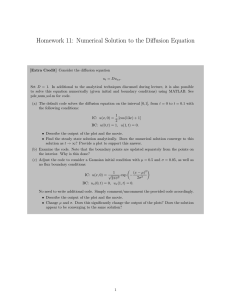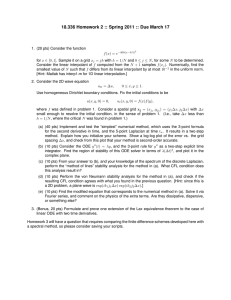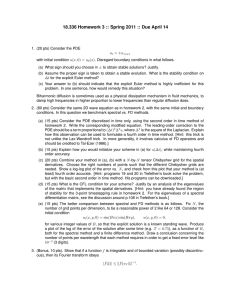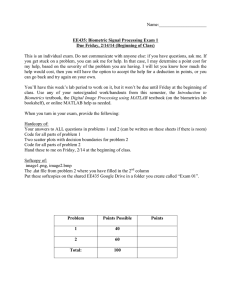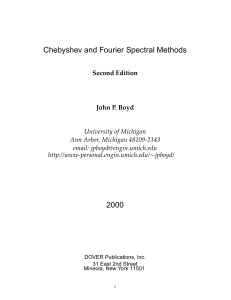18.336 Homework 3 :: Spring 2010 :: Due April 15
advertisement
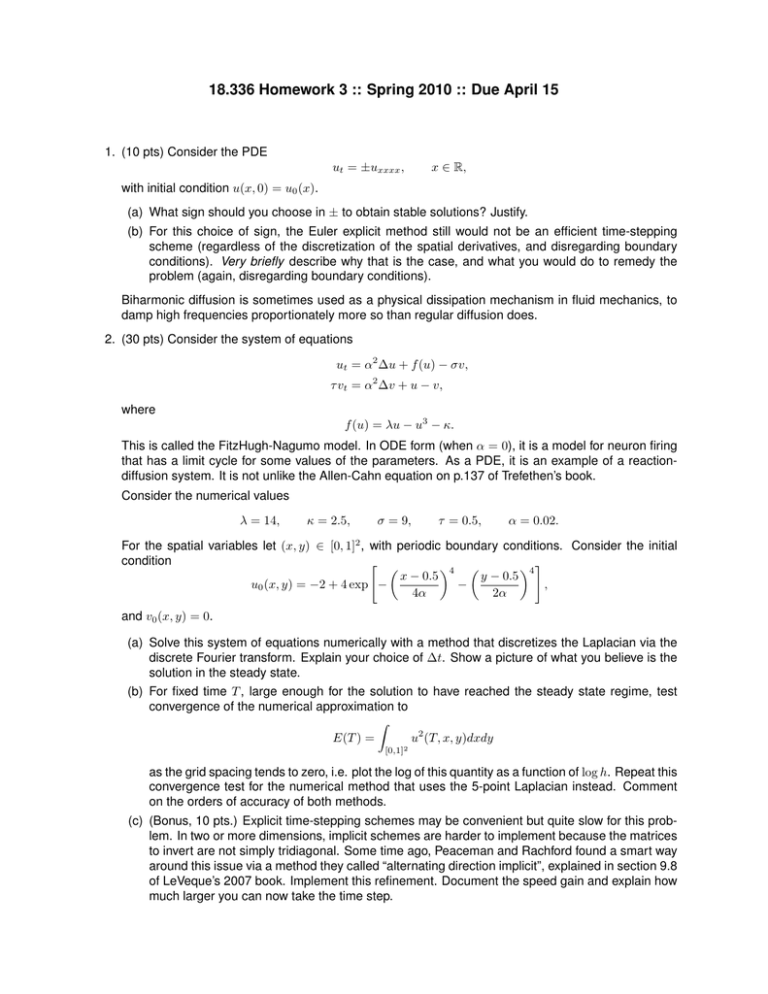
18.336 Homework 3 :: Spring 2010 :: Due April 15 1. (10 pts) Consider the PDE ut = ±uxxxx , x ∈ R, with initial condition u(x, 0) = u0 (x). (a) What sign should you choose in ± to obtain stable solutions? Justify. (b) For this choice of sign, the Euler explicit method still would not be an efficient time-stepping scheme (regardless of the discretization of the spatial derivatives, and disregarding boundary conditions). Very briefly describe why that is the case, and what you would do to remedy the problem (again, disregarding boundary conditions). Biharmonic diffusion is sometimes used as a physical dissipation mechanism in fluid mechanics, to damp high frequencies proportionately more so than regular diffusion does. 2. (30 pts) Consider the system of equations ut = α2 ∆u + f (u) − σv, τ vt = α2 ∆v + u − v, where f (u) = λu − u3 − κ. This is called the FitzHugh-Nagumo model. In ODE form (when α = 0), it is a model for neuron firing that has a limit cycle for some values of the parameters. As a PDE, it is an example of a reactiondiffusion system. It is not unlike the Allen-Cahn equation on p.137 of Trefethen’s book. Consider the numerical values λ = 14, κ = 2.5, σ = 9, τ = 0.5, α = 0.02. For the spatial variables let (x, y) ∈ [0, 1]2 , with periodic boundary conditions. Consider the initial condition " 4 4 # y − 0.5 x − 0.5 − , u0 (x, y) = −2 + 4 exp − 4α 2α and v0 (x, y) = 0. (a) Solve this system of equations numerically with a method that discretizes the Laplacian via the discrete Fourier transform. Explain your choice of ∆t. Show a picture of what you believe is the solution in the steady state. (b) For fixed time T , large enough for the solution to have reached the steady state regime, test convergence of the numerical approximation to Z E(T ) = u2 (T, x, y)dxdy [0,1]2 as the grid spacing tends to zero, i.e. plot the log of this quantity as a function of log h. Repeat this convergence test for the numerical method that uses the 5-point Laplacian instead. Comment on the orders of accuracy of both methods. (c) (Bonus, 10 pts.) Explicit time-stepping schemes may be convenient but quite slow for this problem. In two or more dimensions, implicit schemes are harder to implement because the matrices to invert are not simply tridiagonal. Some time ago, Peaceman and Rachford found a smart way around this issue via a method they called “alternating direction implicit”, explained in section 9.8 of LeVeque’s 2007 book. Implement this refinement. Document the speed gain and explain how much larger you can now take the time step. 3. (60 pts) The hyperbolic system for 2D acoustics considered in homework 2 is ut = −px , vt = −py , pt = −ux − vy . Consider the same domain, initial conditions, and boundary conditions as previously. (a) Implement a spectral method for this problem, by discretizing the equation on a tensor-product Chebyshev grid and computing the derivatives using the idea of Chebyshev polynomials. (b) Test convergence numerically as the grid is refined, i.e. produce a plot of the log of the error for the solution at time T = 0.75 as a function of the number of gridpoints per dimension. Do you observe “spectral” accuracy? Show the corresponding curve for a finite difference method of your choice, on the same plot. (c) The better comparison between spectral and FD methods is as follows. Fix N , the number of grid points per dimension, to be a reasonable power of 2 like 64 or 128. Consider the initial condition p0 (x, y) = sin(Bπx) sin(Bπy), u0 (x, y) = v0 (x, y) = 0, for various integer values of B, so that the explicit solution is a known standing wave. Produce a plot of the log of the error of the solution at time T = 0.75, as a function of B, both for the spectral method and a finite difference method. Draw a conclusion concerning the number of points per wavelength that each method requires in order to get a fixed error level like 10−3 (3 digits). (d) (Bonus, 5 points). Same plot as above, but with a fourth-order method or better in time. The baseline for grading will be half credit if instead of solving the full acoustic system, you only solve the equation for p (that’s ptt = ∆p with homogeneous Dirichlet boundary conditions.) Indicate on your copy in case you choose to go this way. As usual, please include a printout of your codes in what you turn in.
